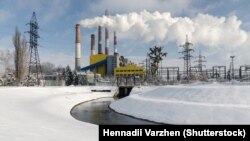KYIV -- Since January 30, all 15 of Ukraine's nuclear reactors have been putting out electricity, marking the longest such stretch of full utilization in the history of a country scarred by the Chernobyl disaster in the Soviet era.
However, it's hardly a moment for celebration.
Rather, it is a reflection of the country's current energy crunch, driven by a combination of surging global prices for natural gas and coal, hostile relations with Russia, and short-sighted domestic policy.
Ukraine's nuclear plants have historically generated most of its power, especially in the winter. But they always had some reserve capacity in case other sources -- such as the country's old, coal-fired generators -- were taken offline for repairs for an extended period of time.
Not now.
With the nuclear power stations running at full throttle, Ukraine is hoping to get through the rest of the heating season without having to purchase significant amounts of expensive gas and coal, which would pile more pressure on an already tight state budget.
The prices of those commodities are expected to fall gradually as the cold weather gives way in late March or early April, says Serhiy Dyachenko, head of the Bureau of Comprehensive Analysis and Forecasting, a Kyiv-based research firm.
With temperatures remaining relatively warm so far, winter has been on Ukraine's side.
Russia, however, is not.
Moscow has reduced energy supplies to Ukraine as it surrounds the country on three sides with troops and weapons in what many in the West fear could be a prelude to a new invasion.
Analysts say any sabotage from Moscow could lead to rolling blackouts in Ukraine and cuts to energy-intensive heavy industry, potentially destabilizing the country.
Andrian Prokip, an energy analyst at the Ukrainian Institute for the Future, likens Ukraine's power industry right now to a car on a long road trip without a backup tire in the trunk. "If you get a flat and don't have a spare tire, you have problems," he said.
Ukraine faced just such a situation late last month when two nuclear reactors had to be disconnected from the grid for almost two days due to technical issues.
As it has regularly done in the past in such instances, the country turned to Belarus for emergency imports.
Ukraine is still connected to the power grid shared by Russia and Belarus and can turn to them for immediate supplies when there is a shortfall. Turning on spare nuclear capacity can take about a day.
That reliance on Belarus and Russia is now a serious liability amid tense relations with both of those neighbors, which are close military allies and have tightened ties since a disputed 2020 presidential election and a brutal crackdown on dissent further isolated Belarusian autocrat Alyaksandr Lukashenka from the West.
Russia currently has more than 100,000 combat-ready troops near Ukraine's borders, some of them just over Ukraine's frontier with Belarus. Citing intelligence, U.S. officials have said Russia is planning for a possible new invasion of Ukraine, eight years after it seized Crimea and fomented separatism in the east, where the ongoing war has killed more than 13,000 people since 2014.
Russia in October canceled a power auction as the energy crunch got under way, a move some analysts viewed as an attempt to squeeze Ukraine, which intended to purchase power during the auction.
There is no guarantee that Belarus will continue to sell Ukraine power in times of emergency, says Volodymyr Omelchenko, head of energy programs at the Razumkov Center. Lukashenka has sharpened his rhetoric toward Ukraine.
The Ukrainian government has publicly downplayed talk of an energy crisis as it has the threat of an imminent invasion. Following a January 25 meeting of the National Security and Defense Council, President Volodymyr Zelenskiy's deputy chief of staff, Rostyslav Shurma, said the current state of the energy industry was "absolutely stable and absolutely under control."
No Money, No Coal
Ukraine has generated on average about 30 to 40 percent of its electricity needs from thermal coal since 2014. That has fallen to 24 percent this winter amid a coal shortage that some analysts say was self-inflicted, driving the need for more output from nuclear plants.
The Ukrainian government had capped electricity prices last year, crimping the earnings of high-cost thermal-coal plants and limiting their ability to stock up on the dirty fuel ahead of the winter season, Omelchenko says.
Meanwhile, natural-gas prices in Europe began surging amid tight supply as economies reopened in 2021 following pandemic-induced shutdowns, pushing power stations across the continent to stock up on coal as a cheaper alternative.
That, in turn, drove coal prices higher. To make matters worse, Russia in November halted exports of coal to Ukraine, forcing it to import from overseas at extraordinarily high prices.
Ukraine's coal shortfall has forced 19 thermal power units to temporarily shut down this winter. The deficit could force Ukraine to generate more electricity from gas, especially if some of the nuclear power plants have to go offline for an extended period.
European Connection
Later this month, Ukraine is set to temporarily disconnect its power system from the grid with Russia and Belarus for at least three days as it tests a future hookup with the European network.
Ukraine plans to fully connect to the European power grid next year, part of an effort to integrate its economy with European Union countries and to reduce reliance on Russia.
Prokip says this presents some short-term danger for Ukraine. "There is a risk that Russian will try to postpone reconnecting or maybe it will refuse. In that case, Ukraine's power system would have to operate without the ability to import supplies," he said.
Recent electricity imports from Belarus amounted to the equivalent of one large nuclear reactor, he adds.
However, fears that Russia would not supply a thermal power station located in the section of the eastern Luhansk region controlled by the Ukrainian government have not yet materialized.
The Luhansk plant normally runs on coal, which can only be supplied by rail from the part of the province controlled by the Kremlin-backed forces. It can also run on more expensive natural gas piped from territory controlled by the Ukrainian government.
Some analysts have said Russia could refuse to deliver coal to the plant in order to squeeze Ukraine's reserves of natural gas. Russia in January sent coal that could keep the plant operating for another month.
Expensive Gas
Ukraine consumes about 30 billion cubic meters (bcm) of gas a year largely for heating and industrial purposes, though a small portion is used to generate electricity. The country produces about two-thirds of its total gas needs, importing the rest.
Unlike with coal, Ukraine built up significant gas reserves heading into the 2021-22 heating season. Nonetheless, it could be forced to buy more if there is a long cold snap and a power shortage caused by a lack of coal imports, technical issues, or sabotage, analysts have said.
In the event of a power shortfall, Ukraine can tap its gas reserves to generate additional electricity. However, the country is hoping to avoid dipping further into its purse for natural gas this winter as prices hover near record highs. The cost of importing an additional 1 bcm would cost more than $1 billion based on current prices, analysts say.
Russia's military buildup has driven up Ukraine's borrowing costs and effectively cut it off from bond markets, making it difficult for Kyiv to finance expenditures.
If it can make it to late March without gas imports and there is no major military offensive, it should be clear sailing, Prokip says.
By that time, domestic gas demand falls to the level of domestic production, he explains.














